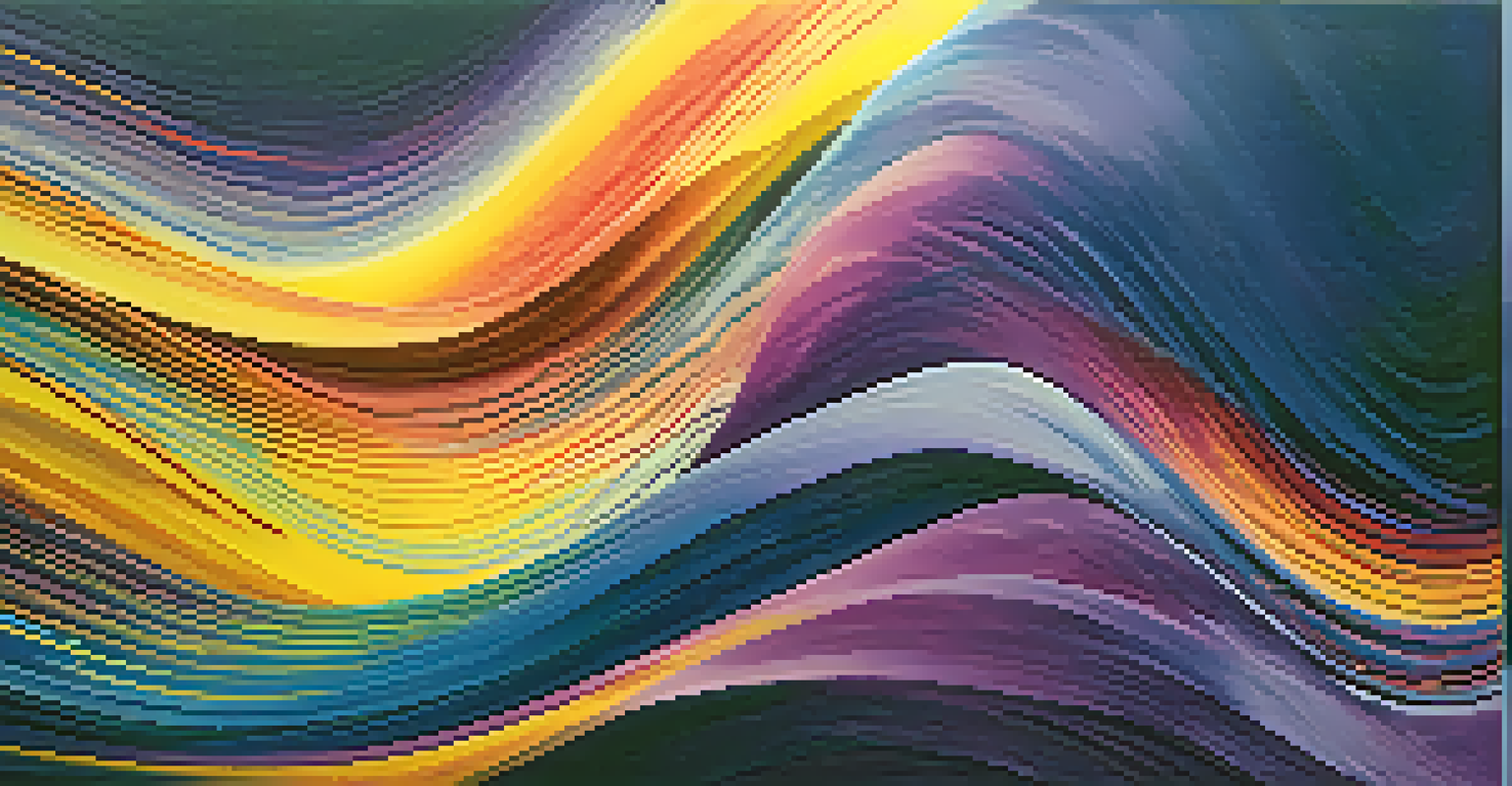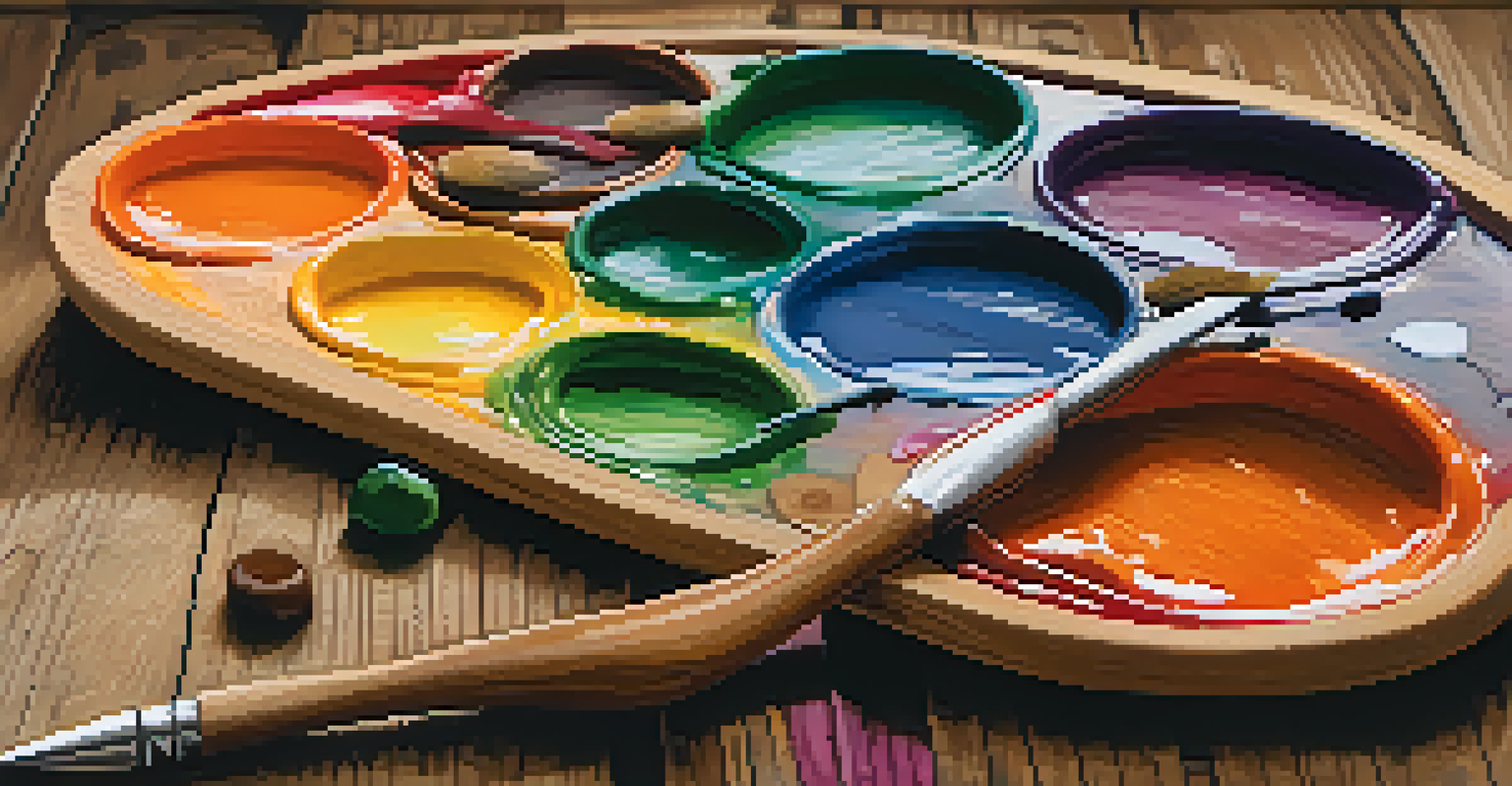Color Theory in Music: Visualizing Sound Through Art

Understanding Color Theory and Its Basics
Color theory is a framework that explores how colors interact and influence emotions. At its core, it divides colors into primary, secondary, and tertiary categories, much like how music uses notes to create harmony. Understanding these relationships helps artists and musicians convey feelings and ideas more effectively, creating a deeper connection with their audience.
Color is the keyboard, the eyes are the harmonies, the soul is the piano with many strings.
In music, just as in visual arts, different colors can evoke different emotions. For example, warm colors like red and yellow can represent excitement or happiness, while cool colors like blue and green might evoke calmness or sadness. This interplay between color and emotion provides a rich backdrop for artists to draw inspiration from, establishing an emotional palette that enhances their work.
By grasping the basics of color theory, musicians can begin to visualize their sound. They can think of their compositions as paintings, where each note and rhythm corresponds to a specific color. This approach not only enriches the creative process but also opens up new avenues for expression by merging auditory and visual experiences.
The Connection Between Sound and Color
Throughout history, artists and musicians have sought to connect sound and color. This idea isn't just whimsical; it has roots in scientific exploration as well. The phenomenon known as synesthesia, where stimulation of one sense leads to involuntary experiences in another, allows some individuals to ‘see’ sounds as colors, enhancing their creative expression.

For example, composers like Franz Liszt and Olivier Messiaen were known to experience synesthesia, associating certain musical notes with specific colors. This experience influenced their compositions, allowing them to create pieces that felt as vibrant and dynamic as a colorful painting. By tapping into their unique perceptions, they pushed the boundaries of traditional music and introduced new textures to the auditory landscape.
Color Theory Enhances Creativity
Understanding color theory allows artists and musicians to visualize their work, enriching their creative expression.
Understanding this connection can inspire musicians to explore their own emotional landscapes. By recognizing which colors resonate with their music, they can cultivate a deeper understanding of their sound, ultimately enhancing their artistic vision. This melding of senses fosters a more immersive experience, both for the creator and the audience.
Color in Music Genres: A Vibrant Spectrum
Different music genres often evoke distinct colors, creating a unique auditory palette. For example, jazz might be associated with deep blues and purples, reflecting its soulful and improvisational nature. In contrast, pop music tends to evoke bright colors like pink and yellow, aligning with its energetic and upbeat rhythms.
Music is the shorthand of emotion.
Each genre’s characteristic sounds can be likened to brush strokes on a canvas, where the choice of color enhances the overall emotional impact. Understanding these associations allows musicians to consciously select colors that resonate with their intended message, providing a richer experience for their audience. This connection between genre and color deepens the listener's engagement and emotional response.
As artists experiment with these color associations, they can blend genres and create innovative sounds that push the boundaries of musical expression. By visualizing their work through color, musicians can craft pieces that not only resonate audibly but also evoke a vivid, emotional experience, akin to watching a story unfold visually.
Visualizing Music: Techniques and Tools
In the digital age, various tools allow musicians to visualize their sound through color. Software like Ableton Live and FL Studio offer visual representations of sound waves, enabling artists to see their music as colorful spectrums. These visual elements can inspire new creative directions and enhance the overall production process.
Moreover, artists can utilize visual art techniques, such as color palettes and mood boards, to guide their music creation. By aligning their musical themes with specific colors, they can create a cohesive artistic vision that resonates with both sound and sight. These techniques encourage a holistic approach to music-making, where the auditory and visual elements work in harmony.
Sound and Color Interconnect
The phenomenon of synesthesia demonstrates how some individuals associate specific sounds with colors, influencing their artistic output.
Using visual tools not only enriches the creative process but also engages listeners on a multi-sensory level. By presenting music alongside visual elements, artists can broaden their impact, making their work more accessible and relatable. This cross-pollination of art forms fosters a deeper appreciation for the nuances of both music and color.
Famous Artists Merging Sound and Color
Several renowned artists have brilliantly merged sound and color in their works. Wassily Kandinsky, a pioneer of abstract art, famously believed that colors and shapes could express musical ideas. His paintings often reflect this philosophy, where vibrant colors and dynamic forms evoke the emotions found in music.
Another notable figure is the composer John Cage, who experimented with unconventional sounds and silence, challenging traditional notions of music. Cage's work encourages listeners to perceive sound in new ways, much like how one might interpret a painting. His innovative approach highlights the beauty of embracing spontaneity, allowing the colors of sound to dance freely in the listener's mind.
These artists exemplify the powerful synergy between visual arts and music. By blending these creative mediums, they offer audiences a richer, more immersive experience, inviting them to explore the emotional depths of both sound and color. Their legacies inspire current and future artists to continue this exploration, paving the way for new artistic expressions.
The Role of Emotion in Color and Sound
Emotion plays a pivotal role in how we perceive both color and sound. Just as a bright red can evoke feelings of passion or anger, a powerful musical crescendo can stir excitement or fear. This emotional interplay is key to understanding how artists can create complex, layered experiences that resonate with their audiences.
Musicians often draw on their own emotional experiences when creating their work, which can then translate into specific colors. For example, a melancholic melody might be represented by muted blues and grays, while an uplifting song could be visualized with bright yellows and greens. This emotional mapping allows artists to convey their feelings more authentically and profoundly.
Emotion Shapes Artistic Expression
Artists can convey deeper emotional experiences by mapping colors to the feelings evoked by their music.
By recognizing the emotional connections between color and sound, artists can craft pieces that speak directly to the heart. This emotional resonance not only enriches the artistic experience but also fosters a deeper connection between the creator and the audience. Ultimately, this synergy allows for a shared journey through the complexities of human emotion.
Bridging the Gap: Art and Music Education
Integrating color theory into music education can enhance students' understanding of both disciplines. By teaching students to visualize sound through color, educators can foster a more holistic approach to learning. This method encourages creativity and critical thinking, allowing students to explore their unique artistic voices.
Workshops and collaborative projects that combine visual arts and music can provide students with valuable hands-on experience. For instance, creating art inspired by a musical composition can help students grasp the emotional nuances of both fields. Such interdisciplinary approaches not only deepen their understanding but also cultivate a greater appreciation for the interconnectedness of art forms.

Ultimately, bridging the gap between music and visual arts opens up exciting possibilities for future artists. It nurtures a generation of creators who are equipped to explore and express their thoughts and feelings in innovative ways. By embracing this integration, educators can inspire students to think outside the box and redefine the boundaries of artistic expression.